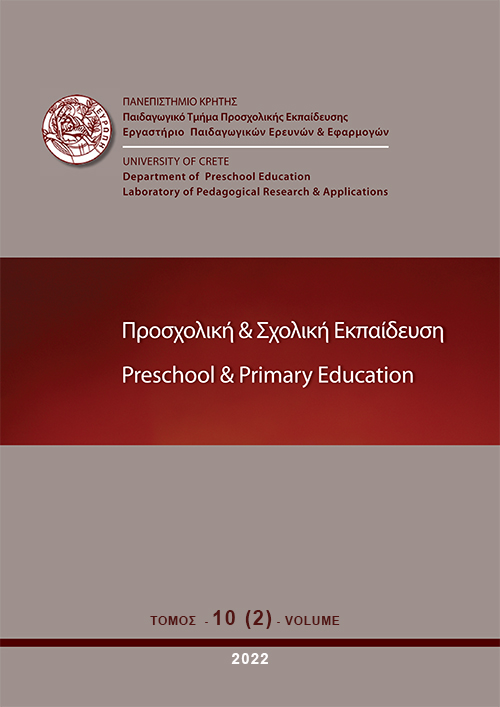Αποδομώντας πέντε διαδεδομένους μύθους για τη χαρισματικότητα και τους χαρισματικούς μαθητές

Περίληψη
Τα χαρισματικά παιδιά αποτελούν έναν σχετικά παραμελημένο μαθητικό πληθυσμό, με περιορισμένη πρόσβαση σε εξειδικευμένες εκπαιδευτικές παρεμβάσεις για την καλλιέργεια και την ανάδειξη των ιδιαίτερων ταλέντων τους. Η επικράτηση μιας σειράς παρανοήσεων γύρω από τη χαρισματικότητα, τις ανάγκες και τα χαρακτηριστικά των χαρισματικών μαθητών τείνει να δυσχεραίνει περαιτέρω την προσπάθεια για την αποτελεσματική εκπαιδευτική και ψυχοπαιδαγωγική τους προσέγγιση. Υπό αυτό το πρίσμα, η παρούσα εργασία αποβλέπει στην αποδόμηση πέντε ιδιαίτερα διαδεδομένων μύθων γύρω από τη χαρισματικότητα και τους χαρισματικούς μαθητές, όπως αυτοί εντοπίστηκαν μέσω απλής ανασκόπησης στη διεθνή και την ελληνική βιβλιογραφία και εκκινώντας από σχετικό αφιερωματικό τεύχος του περιοδικού Gifted Childhood Quarterly. Από την ανασκόπηση διαπιστώθηκαν και αναδεικνύονται πέντε συχνές παρανοήσεις και στερεότυπα σχετικά με τον ορισμό, τις εκδηλώσεις της χαρισματικότητας, καθώς και με τις ανάγκες και τις δυνατότητες των χαρισματικών μαθητών. Η αποδόμησή τους γίνεται μέσα από την αντιπαραβολή ερευνητικών ευρημάτων και σύγχρονων επιστημονικών θεωριών που ενισχύουν τη γνώση για την εκπαίδευση των χαρισματικών παιδιών και προωθούν τεκμηριωμένες πρακτικές για τη συμπερίληψη των μαθητών αυτών.
Λεπτομέρειες άρθρου
- Πώς να δημιουργήσετε Αναφορές
-
Τουλουμάκου Ά., Μπελογιάννη Β., Barrable, A., & Λαδά Μ. Σ. (2022). Αποδομώντας πέντε διαδεδομένους μύθους για τη χαρισματικότητα και τους χαρισματικούς μαθητές. Preschool and Primary Education, 10(2), 153–174. https://doi.org/10.12681/ppej.27749
- Ενότητα
- Άρθρα

Αυτή η εργασία είναι αδειοδοτημένη υπό το CC Αναφορά Δημιουργού – Μη Εμπορική Χρήση – Παρόμοια Διανομή 4.0.
Οι συγγραφείς των άρθρων που δημοσιεύονται στο ΠΡΟΣΧΟΛΙΚΗ & ΣΧΟΛΙΚΗ ΕΚΠΑΙΔΕΥΣΗ διατηρούν τα δικαιώματα πνευματικής ιδιοκτησίας επί των άρθρων τους, δίνοντας στο περιοδικό το δικαίωμα της πρώτης δημοσίευσης. Άρθρα που δημοσιεύονται στο ΠΡΟΣΧΟΛΙΚΗ & ΣΧΟΛΙΚΗ ΕΚΠΑΙΔΕΥΣΗ διατίθενται με άδεια Creative Commons 3.0 και σύμφωνα με την άδεια μπορούν να χρησιμοποιούνται ελεύθερα, με αναφορά στο/στη συγγραφέα και στην πρώτη δημοσίευση για μη κερδοσκοπικούς σκοπούς και με δικαίωμα τροποποίησης μόνον με παρόμοια διανομή (αν αναμείξετε, τροποποιήσετε, ή δημιουργήσετε πάνω στο υλικό, πρέπει να διανείμετε τις δικές σας συνεισφορές υπό την ίδια άδεια όπως και το πρωτότυπο). To Εργαστήριο Παιδαγωγικών Ερευνών και Εφαρμογών του Παιδαγωγικού Τμήματος Προσχολικής Εκπαίδευσης του Πανεπιστημίου Κρήτης και το Εθνικό Κέντρο Τεκμηρίωσης διατηρούν το δικαίωμα να δημοσιεύουν, να αναπαραγάγουν, να παρουσιάζουν στο κοινό, να διανέμουν και χρησιμοποιούν άρθρα που δημοσιεύονται στο ΠΡΟΣΧΟΛΙΚΗ & ΣΧΟΛΙΚΗ ΕΚΠΑΙΔΕΥΣΗ σε οποιοδήποτε μέσο και μορφή είτε μεμονωμένα είτε ως μέρη συλλογικών έργων, για όλο το χρόνο διάρκειας προστασίας της πνευματικής ιδιοκτησίας και για όλες τις χώρες του κόσμου. Αυτό περιλαμβάνει ενδεικτικά και όχι αποκλειστικά, το δικαίωμα δημοσίευσης των άρθρων σε τεύχη του περιοδικού ΠΡΟΣΧΟΛΙΚΗ & ΣΧΟΛΙΚΗ ΕΚΠΑΙΔΕΥΣΗ, αναπαραγωγής και διανομής μεμονωμένων αντιγράφων των άρθρων, αναπαραγωγής ολόκληρων των άρθρων σε άλλη έκδοση του Εργαστηρίου Παιδαγωγικών Ερευνών και Εφαρμογών του Παιδαγωγικού Τμήματος Προσχολικής Εκπαίδευσης του Πανεπιστημίου Κρήτης και του Εθνικού Κέντρου Τεκμηρίωσης και αναπαραγωγής και διανομής των άρθρων ή περίληψης αυτών με χρήση πληροφορικού συστήματος αποθετηρίου.


